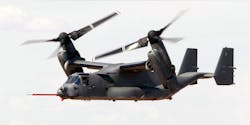Boeing has announced the opening of a new production facility for the V-22 Osprey, a joint services aircraft for the U.S. Marine Corps and U.S. Navy. Located outside of Philadelphia, Pa., the advanced facility will house fuselage production lines for the U.S. Air Force, Marines, and Navy for the tiltrotor aircraft, helping to modernize the MV-22 Osprey fleet for the Marines (see figure). The facility will also serve as home for the Common Configuration–Readiness Modernization (CC-RAM) program that standardizes and upgrades previously built aircraft to the new Block C configuration.
This new production facility outside was constructed to help modernize the V-22 Osprey tiltrotor combat aircraft. (Courtesy of Boeing)
The V-22 Osprey is a multiple-role combat aircraft that combines the vertical capabilities of a helicopter with the speed and range of a fixed-wing aircraft. It can take off and land like a helicopter and, once airborne, is capable of high-speed, high-altitude flight. The combat aircraft has a maximum cruise speed of 500 km/h and a mission radius of 428 nautical miles.
“The V-22 readiness program is our number one priority,” says U.S. Marine Corps Col. Matthew Kelly, V-22 Joint Program Manager. “The CC-RAM program is key in meeting our readiness goals and returning capable and reliable aircraft to Marine units around the world.”
The new facility will bring the latest production equipment to the assembly of the V-22 Osprey fuselage, as part of modernizing the aircraft leading to improved safety and productivity, as well as lowering operating costs.
About the Author
Jack Browne
Technical Contributor
Jack Browne, Technical Contributor, has worked in technical publishing for over 30 years. He managed the content and production of three technical journals while at the American Institute of Physics, including Medical Physics and the Journal of Vacuum Science & Technology. He has been a Publisher and Editor for Penton Media, started the firm’s Wireless Symposium & Exhibition trade show in 1993, and currently serves as Technical Contributor for that company's Microwaves & RF magazine. Browne, who holds a BS in Mathematics from City College of New York and BA degrees in English and Philosophy from Fordham University, is a member of the IEEE.


